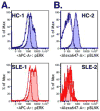Altered B cell receptor signaling in human systemic lupus erythematosus
- PMID: 18723129
- PMCID: PMC2693706
- DOI: 10.1016/j.autrev.2008.07.047
Altered B cell receptor signaling in human systemic lupus erythematosus
Abstract
Regulation of B cell receptor signaling is essential for the development of specific immunity while retaining tolerance to self. Systemic lupus erythematosus (SLE) is characterized by a loss of B cell tolerance and the production of anti-self antibodies. Accompanying this break down in tolerance are alterations in B cell receptor signal transduction including elevated induced calcium responses and increased protein phosphorylation. Specific pathways that negatively regulate B cell signaling have been shown to be impaired in some SLE patients. These patients have reduced levels of the kinase Lyn in lipid raft microdomains and this reduction is inversely correlated with increased CD45 in lipid rafts. Function and expression of the inhibitory immunoglobulin receptor FcgammaRIIB is also reduced in Lupus IgM- CD27+ memory cells. Because the relative contribution of different memory and transitional B cell subsets can be abnormal in SLE patients, we believe studies targeted to well defined B cell subsets will be necessary to further our understanding of signaling abnormalities in SLE. Intracellular flow cytometric analysis of signaling is a useful approach to accomplish this goal.
Figures

References
-
- Goodnow CC, Sprent J, Fazekas de St Groth B, Vinuesa CG. Cellular and genetic mechanisms of self tolerance and autoimmunity. Nature. 2005;435:590–7. - PubMed
-
- Ferraccioli G, Tolusso B. Infections, B cell receptor activation and autoimmunity: different checkpoint impairments lead to autoimmunity, clonal B cell expansion and fibrosis in different immunological settings. Autoimmun Rev. 2007;7:109–13. - PubMed
-
- Crispin JC, Kyttaris VC, Juang YT, Tsokos GC. How signaling and gene transcription aberrations dictate the systemic lupus erythematosus T cell phenotype. Trends Immunol. 2008;29:110–5. - PubMed
-
- Tenbrock K, Juang YT, Kyttaris VC, Tsokos GC. Altered signal transduction in SLE T cells. Rheumatology (Oxford) 2007;46:1525–30. - PubMed
-
- Katsiari CG, Tsokos GC. Transcriptional repression of interleukin-2 in human systemic lupus erythematosus. Autoimmun Rev. 2006;5:118–21. - PubMed
Publication types
MeSH terms
Substances
Grants and funding
LinkOut - more resources
Full Text Sources
Research Materials
Miscellaneous

